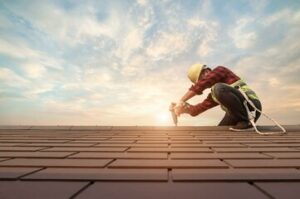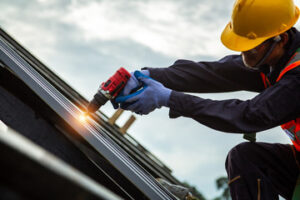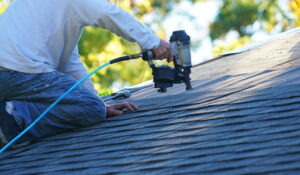Detecting and repairing roof damage early will help to minimize ongoing problems like water stains in living spaces and structural damage. Inspect your attic space for leaks and look along the walls of the house around chimneys, skylights, and vents.

Visible signs of damage, including holes, can usually be repaired with a patch or replacement. More widespread damage, however, may require a full roof replacement. Contact Columbus Roof Repair for professional help.
The roof of a home is the most critical line of defense against the elements. The roof protects the structure, insulation, and ceilings of a house, shielding it from water intrusion that can lead to expensive and inconvenient leaks. As such, a damaged or worn roof must be addressed promptly to prevent small issues from snowballing into major catastrophes. Damaged shingles are one of the most common reasons homeowners call for roof repair services.
High winds, falling debris, and even careless foot traffic on a roof can cause shingle damage that weakens the roofing underlayment, exposing the interior of your home to moisture intrusion. Learning how to fix a damaged shingle is a valuable skill to have, but significant damage may require the expertise of a professional roofing contractor.
In most cases, the first sign of a shingle problem is a noticeable loss or tear. Often, this is due to wind-induced pressure that causes the shingle to fold upward and expose the underlayment. This pressure can also result in creases or ridges in the roof surface, which show up as darker lines in the roofing material.
Other signs of a shingle issue are a blistering or curling of the shingle, which can be caused by exposure to excessive heat or by aging due to natural wear and tear. You might also notice that a roof has become more opaque, which is a result of fading or discoloration caused by sunlight or algae.
It is recommended that homeowners perform a visual inspection of their roof on a regular basis. This allows for the identification of shingle damage, which can be easily fixed before it becomes a more serious issue. In addition, a roof repair professional can help guide homeowners through the insurance claim process, helping to ensure that all damages are properly covered.
Begin your shingle repair by locating the damaged area of the roof and removing any loose or dislodged shingles. It is important to work on a warm, dry afternoon when performing this task as shingles are more pliable in these conditions and less likely to crack or break. Position a flat pry bar under the shingle immediately above the damaged shingle. Gently lift the shingle to release the sealer strip and reveal the first row of nails. Use a utility knife to cut around the nails and lift up the shingle, then insert a replacement 3-tab shingle in its place and nail down.
Leaking Gutters
Gutters are designed to channel water away from the house, but sometimes gutters develop leaks. Gutter leaks can cause serious damage if not repaired promptly. The good news is that, with a little effort, you can fix many gutter leaks yourself.
One of the most common reasons for a leaking gutter is that it hasn’t been cleaned regularly. Gutters can easily become clogged with leaves, twigs and other debris. Over time, this can force the gutters to sag and create space between the gutters and the fascia board, where water can leak into the home.
Another common problem is that the gutters may have an improper slope. If the gutters have too low a slope, it can lead to overflow during heavy rains. The standing water can then saturate the soil surrounding the gutter, leading to rot and other problems.
Finally, the gutters might be leaking due to loose fasteners or corrosion. Depending on the type of gutter, the fasteners can be secured with screws or nails that are nailed to the fascia boards or sleeve-and-spike supports. Over time, these fasteners can become loose and shift the gutters, which can also lead to a leak.
If you find a crack or hole in your gutter, you can try to repair it by cleaning the area and applying a sealant or caulk. Make sure to use a sealant that is specifically made for gutters. If you have a metal gutter, you should check for rust spots and clean them thoroughly with a wire brush before applying the sealant. For plastic gutters, you can try a roofing sealant or guttering tape. If the gutters are corroded, you can replace the entire section of guttering. If you’re not comfortable working at heights, it’s a good idea to contact your local roofer for help with any repairs. They can reseal the joints to prevent leaks and ensure that the gutter is pitched properly. This will help prevent leaking gutters from becoming damaged again in the future.
Damaged Flashing
Flashing is a long, thin strip of metal that protects the vulnerable areas of your roof. It is installed around chimneys, walls, vent pipes, dormers, skylights, and other roof transitions. It is usually made of rust-resistant galvanized sheet metal, though aluminum and copper are also used for specific applications. Flashing is sealed tightly against the surface of your roof with a special roofing cement, and it helps prevent water from seeping in through these vulnerable areas.
Over time, however, flashing can become damaged or deteriorated. This is particularly true in harsh weather conditions, such as those found in North Texas. If left untreated, leaking flashing can lead to water damage within your home. Water damage can cause rotting wood, deteriorating insulation, and mold growth. It can also cause wet rot in timber joists and framing, which may eventually compromise the structural integrity of your home.
A professional roofer will inspect your roof to locate areas where flashing may be damaged or need repair. He will take particular care when inspecting the roof around chimneys, vents, and other transitions. He will check for visible rust or corrosion, cracks, gaps, and loose flashing. He will also look for signs of water leaks, such as stains on ceilings or walls.
If you notice a problem with your roof flashing, it is important to act quickly. A professional roofer will replace your damaged flashing with new material, making sure it is properly fitted and sealed to the underlying roofing materials. He will also make sure that the edges of the flashing are properly covered and protected.
If you are concerned about the condition of your roof flashing, or have noticed water leaks within your home, contact Panda Exteriors for a roof inspection and repair services. We have the expertise, experience, and specialized tools to properly assess your roof’s condition and provide prompt, effective repair solutions to ensure your home is well-protected against water damage. Contact us today to schedule an appointment. We proudly serve homeowners in Dallas, Fort Worth, and the surrounding area.
Built-Up Roofing
A built-up roof (BUR) is a multi-layered asphalt roofing system that offers durability and long lifespans. BUR is a common choice for commercial and industrial buildings with flat or low-sloped roofs due to its insulation, water resistance, and fire protection. BUR’s longevity and cost-efficiency make it a great option for building owners looking to invest in a durable roofing solution.
The building owners and roofing professionals who choose to use a BUR must understand that this is not a maintenance-free roof system. In fact, the opposite is true – BUR needs regular professional inspections to ensure it continues to offer protection for your structure. These inspections can uncover a variety of issues, from clogged drains to pitch pockets that need to be topped off. It’s also important to look for leak-causing penetrations and blemishes on the surface of your roof, as well as any other signs of wear.
If your building has a BUR, you can expect to get about 20-30 years out of it, depending on the number of layers (also known as piles) and how well the roof was installed. The more layers a BUR has, the longer it will last. BUR systems are also surprisingly resilient against physical damage, like hail or falling branches.
One of the main reasons for this is that the tar and gravel in a built-up roof provide extra physical strength and protect it from sun, wind, and debris. These factors are especially important in Florida, where the sun and weather can cause significant damage to your roofing.
The installation of a built-up roof is somewhat labor intensive, as it requires hot asphalt or tar to apply each layer. The resulting odors and fumes can be a nuisance for occupants who have respiratory concerns, so proper ventilation is essential during the installation process.
While newer roofing technologies have gained popularity in recent years, many building owners and roofing contractors still prefer a built-up roof due to its durability and longevity. When considering whether or not this is the right choice for your building, consult with a knowledgeable Elevate roofing contractor to discuss your needs and options.

